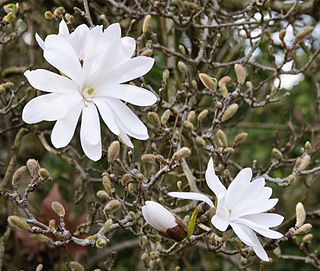
Magnolia stellata, sometimes called the stellaris magnolia, is a slow-growing shrub or small tree native to Japan. It bears large, showy white or pink flowers in early spring, before its leaves open. This species is closely related to the Kobushi magnolia, and is treated by many botanists as a variety or even a cultivar of that. However, Magnolia stellata was accepted as a distinct species in the 1998 monograph by Hunt.

Hibiscus syriacus is a species of flowering plant in the mallow family, Malvaceae. It is native to south-central and southeast China, but widely introduced elsewhere, including much of Asia, both in the east and the west. It was given the epithet syriacus because it had been collected from gardens in Syria. Common names include the rose of Sharon,, Syrian ketmia, shrub althea, and rose mallow. It is the national flower of South Korea and is mentioned in the South Korean national anthem.
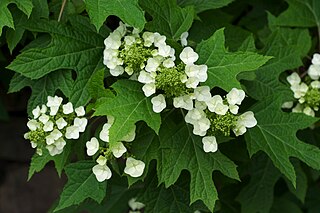
Hydrangea quercifolia, commonly known as oakleaf hydrangea or oak-leaved hydrangea, is a species of flowering plant in the family Hydrangeaceae. It is native to the southeastern United States, in woodland habitats from North Carolina west to Tennessee, and south to Florida and Louisiana. A deciduous shrub with white showy flower heads, it is grown as a garden plant, with numerous cultivars available commercially.
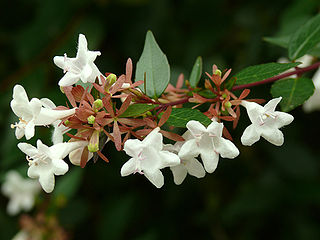
Linnaea × grandiflora, synonym Abelia × grandiflora, is a hybrid species of flowering plant in the honeysuckle family Caprifoliaceae, raised by hybridising L. chinensis with L. uniflora.

Abutilon pictum, syn. Abutilon striatum (disputed), is a species of flowering plant in the family Malvaceae. It is native to southern Brazil, Argentina, Paraguay and Uruguay. The plant has become naturalised in Central America, and is used in horticulture. Common names include redvein abutilon, red vein Indian mallow, redvein flowering maple, Chinese-lantern and red vein Chinese lanterns.

Lavandula angustifolia, formerly L. officinalis, is a flowering plant in the family Lamiaceae, native to the Mediterranean. Its common names include lavender, true lavender and English lavender ; also garden lavender, common lavender and narrow-leaved lavender.

Cornus alba, the red-barked, white or Siberian dogwood, is a species of flowering plant in the family Cornaceae, native to Siberia, northern China and Korea. It is a large deciduous surculose (suckering) shrub that can be grown as a small tree. As a popular ornamental used in landscaping its notable features include the red stems in fall (autumn) through late winter, bright winter bark; and the variegated foliage in some cultivars, such as C. alba 'Elegantissima'. C. alba can grow to 3 m (10 ft) high, but variegated forms are less vigorous. For the brightest winter bark, young shoots are encouraged by cutting to the ground some older stems at the end of the winter, before leaves are open. The oval fruits are white, sometimes tinted blue.

Eremurus robustus, the foxtail lily or giant desert candle, is a species of flowering plant in the asphodel family, native to the Tien Shan and Pamir Mountains in Central Asia, that is often used as an ornamental plant.

Phlox subulata the creeping phlox, moss phlox, moss pink or mountain phlox, is a species of flowering plant in the family Polemoniaceae, native to eastern and central USA, and widely cultivated.

Plumbago auriculata, the Cape leadwort, blue plumbago or Cape plumbago, is a species of flowering plant in the family Plumbaginaceae, native to South Africa and Mozambique.

Phlomis fruticosa, the Jerusalem sage, is a species of flowering plant in the family Lamiaceae, native to Albania, Cyprus, Greece, Italy, Turkey, and countries of the former Yugoslavia.

Sorbaria sorbifolia, the false spiraea, is a species of flowering plant in the family Rosaceae. The common name is also spelled false spirea. Other common names include false goat's beard, sorb-leaved schizonotus, Ural false spirea, and in Chinese: 珍珠梅; pinyin: zhen zhu mei; lit. 'pearl plum'.

Salvia microphylla, the baby sage, Graham's sage, or blackcurrant sage, is an evergreen shrub found in the wild in southeastern Arizona and the mountains of eastern, western, and southern Mexico. It is a very complex species which easily hybridizes, resulting in numerous hybrids and cultivars brought into horticulture since the 1990s. The specific epithet microphylla, from the Greek, means "small leaved". In Mexico it is called mirto de montes, or "myrtle of the mountains".

Forsythia × intermedia, or border forsythia, is an ornamental deciduous shrub of garden origin.

Salix acutifolia, also known as Siberian violet-willow, long-leaved violet willow or sharp-leaf willow, is a species of flowering plant in the family Salicaceae, native to Russia and eastern Asia. It is a spreading, deciduous shrub or tree, growing to 10 m (33 ft) tall by 12 m (39 ft) wide. The young shoots are deep purple with a white bloom. The leaves are narrow, up to 10 cm (4 in) long. The catkins are produced in early spring, before the leaves. Older bark has a fine, netted pattern.
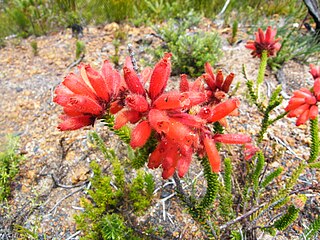
Erica cerinthoides is a species of heath native to South Africa, Lesotho and Eswatini. Common names include fire erica, fire heath, red hairy heath, rooihaartjie or klipheide. Throughout its range the species shows marked variation in habit, flower characteristics and hairiness. A form with white flowers is found in Eswatini and the South African province of Mpumalanga while the variety E. cerinthoides var. barbertona has shorter flowers.
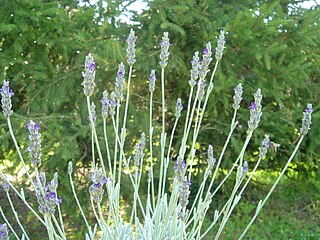
Lavandula lanata, the woolly lavender, is a species of flowering plant in the family Lamiaceae, native to southern Spain. An evergreen dwarf shrub growing to 1 m (3.3 ft) tall and broad, it is noted for the pronounced silver woolly hairs on its leaves, whence the Latin specific epithet lanata. The deep violet purple flowers are borne on narrow spikes, and give off the familiar lavender scent.
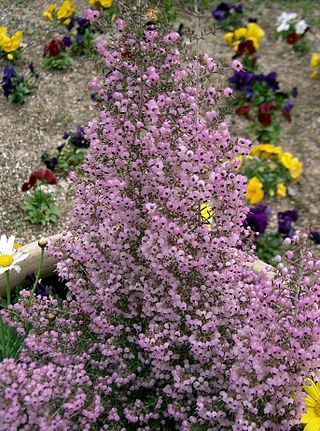
Erica canaliculata, the channelled heath or hairy grey heather, is a species of flowering plant in the family Ericaceae. The species is native to the East and West Capes of South Africa and naturalised in South Australia. It is an erect evergreen shrub, sometimes described as a tree heath. It grows to 2 m, with tiny dark green leaves and large sprays of pink or white flowers with prominent brown anthers in winter and spring.

Erica versicolor is a species of flowering plant in the family Ericaceae, native to South Africa’s Cape Province.

Plectranthus fruticosus, the forest spurflower, is a species of flowering plant in the mint family, Lamiaceae. It is native to Mozambique, Eswatini, and South Africa's KwaZulu-Natal, Northern, and Cape provinces. Growing up to 2 m (6.6 ft) tall, it is an erect evergreen shrub, with rounded, hairy leaves, and spikes of soft blue or mauve flowers in summer.


























